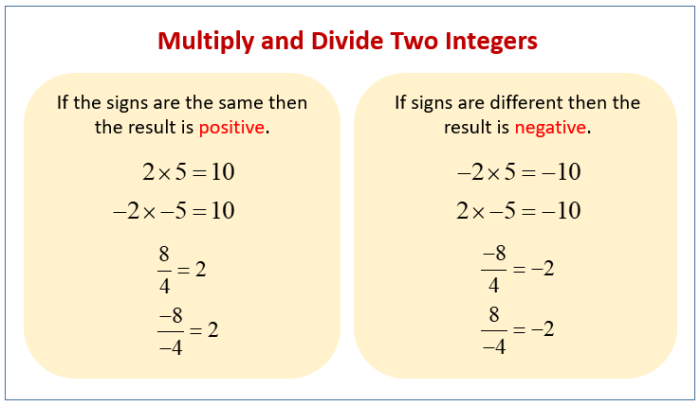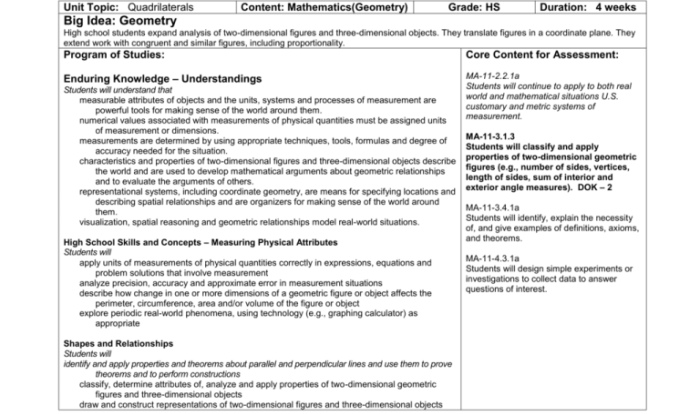Word problems multiplying and dividing integers present a unique set of challenges and opportunities for students. By understanding the rules and strategies involved, students can effectively solve these problems and apply their knowledge to real-world situations.
This comprehensive guide provides a detailed overview of integer multiplication and division, explores real-world applications, and offers strategies for solving word problems involving these operations. It also addresses common pitfalls and misconceptions to ensure a thorough understanding of the topic.
Multiplying and Dividing Integers: An Overview: Word Problems Multiplying And Dividing Integers

Integers are numbers that can be positive, negative, or zero. Multiplying and dividing integers follows specific rules to ensure accurate calculations. When multiplying integers, the signs of the numbers determine the sign of the product: positive multiplied by positive or negative multiplied by negative results in a positive product, while positive multiplied by negative or negative multiplied by positive results in a negative product.
Dividing integers follows similar rules: the sign of the quotient is positive when the signs of the dividend and divisor are the same, and negative when the signs are different. These rules are essential for solving mathematical problems involving integers.
Real-World Applications of Integer Multiplication and Division
Integer multiplication and division find practical applications in various fields:
- Finance:Calculating interest on loans or investments, determining profit or loss.
- Science:Solving equations involving temperature changes, calculating speed and distance.
- Everyday life:Dividing a pizza equally among friends, determining the number of days left in a month.
Strategies for Solving Word Problems Involving Integer Multiplication and Division
Solving word problems involving integers requires careful analysis and application of the rules of multiplication and division:
- Read and understand the problem:Identify the given information and what is being asked.
- Translate the problem into an equation:Use integers to represent the quantities and apply the appropriate operations.
- Solve the equation:Apply the rules of integer multiplication and division to find the solution.
- Check the answer:Ensure the solution makes sense in the context of the problem.
Common Pitfalls and Misconceptions, Word problems multiplying and dividing integers
Common errors when multiplying and dividing integers include:
- Ignoring the signs:Forgetting to consider the signs of the numbers when multiplying or dividing.
- Misinterpreting the quotient:Assuming the quotient is always positive, even when the dividend and divisor have different signs.
- Incorrect division by zero:Dividing any number by zero results in an undefined expression.
Practice Exercises and Examples
- Multiply: (-5) x (-3)
- Divide: (-12) ÷ 4
- Solve the word problem: A store has 15 apples. If they divide the apples equally among 3 baskets, how many apples will be in each basket?
FAQ Compilation
What are the rules for multiplying and dividing integers?
When multiplying integers, the signs of the numbers determine the sign of the product: positive x positive = positive, positive x negative = negative, negative x positive = negative, negative x negative = positive. When dividing integers, the sign of the quotient is determined by the signs of the dividend and divisor: positive ÷ positive = positive, positive ÷ negative = negative, negative ÷ positive = negative, negative ÷ negative = positive.
What are some real-world applications of integer multiplication and division?
Integer multiplication and division are used in various fields, including finance (calculating interest and profits), science (determining the speed and distance of objects), and everyday life (counting objects and measuring quantities).
What are some common pitfalls and misconceptions when solving word problems involving integer multiplication and division?
Common pitfalls include forgetting to consider the signs of the numbers, incorrectly applying the order of operations, and misinterpreting the problem statement. Misconceptions may include assuming that all negative numbers are less than positive numbers or that division is always possible.


